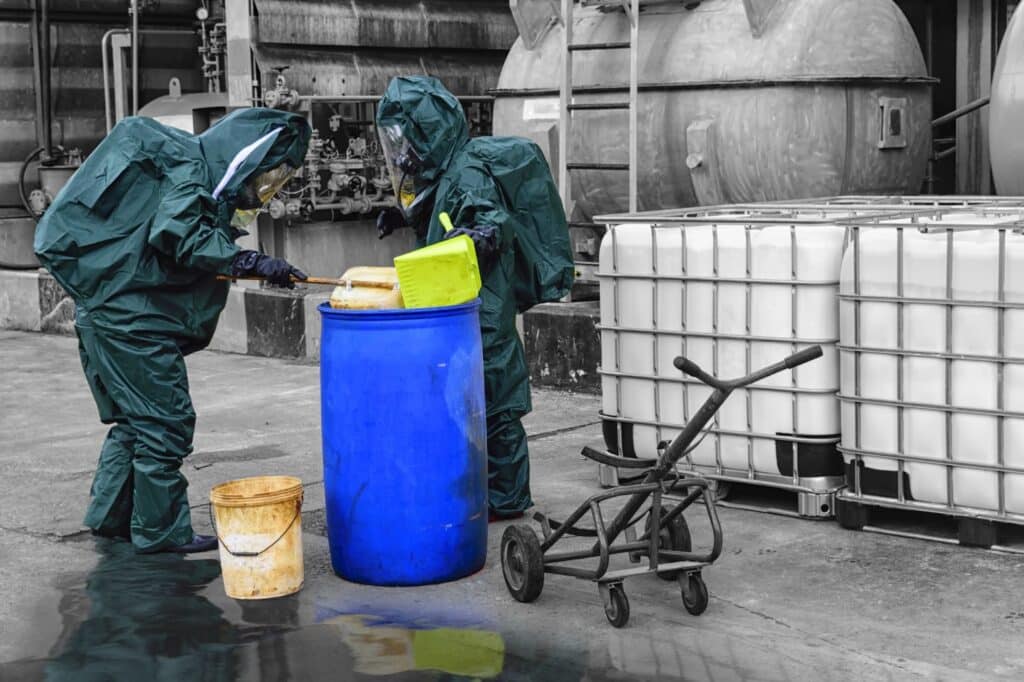A Quick Guide to Chemical Spill Response and Procedures

This guide covers the key steps during a chemical spill response, including protocols and containment. Learn how to manage a chemical spill in the workplace.
Hazardous chemicals can contaminate water sources, disrupt ecosystems, and threaten public safety. It’s essential to respond quickly and effectively if a chemical spill occurs. This guide outlines the key steps to take when responding to a chemical spill so that you can safely clean up the mess and protect everyone involved.
How Dangerous is a Chemical Spill?
Chemical spills can range from minor to major, with the potential to cause harm to human health and the environment. Some toxic chemicals can cause serious injury or death if ingested or inhaled. Others can be flammable and pose a fire risk. Understanding the dangers of different chemicals is essential to assess the risk and respond appropriately.
Why Is Chemical Spill Response Important?
An effective chemical spill response is crucial because it helps reduce the spill’s impact on human health and the environment. A prompt and effective response can prevent further damage, reduce the risk of injury, and minimise the costs associated with the spill.
Minor and Major Chemical Spill
Chemical spills can be classified into two categories, minor and major, according to the following criteria:
Quantity of Chemical
A minor chemical spill is defined as a spill of a small quantity of chemical that poses a low risk. A major spill involves a significant amount of chemical that poses a significant risk.
The Hazardous Chemical
The type of chemical spilled is also important in determining the level of risk posed by a spill. Some chemicals are highly toxic, flammable, or reactive and require a different response than other chemicals.
Location of Chemical
The location of the spill can also impact the level of risk posed by a spill. Spills in populated areas or near sensitive ecosystems pose a greater risk than spills in remote areas.
Chemical Spill Response Procedure
In the event of a chemical spill, it’s essential to follow the proper response procedures to reduce the spill’s impact.
Alert and Evacuate
The first step in the response procedure is to alert others and evacuate the area if necessary. This helps to prevent further exposure to the spilled chemical and reduces the risk of injury.
Assess the Risk and Type of Liquid Material
Next, it’s crucial to assess the risk posed by the spill and determine the type of chemical that was spilled. This information is critical to making informed decisions about how to respond to the spill.
Confine the Spill
The next step is to contain the spill to prevent it from spreading. This helps minimise the spill’s impact on the environment and reduces the risk of further damage.
Stop the Leak (if Safe to Do)
If it is safe to do so, stop the source of the spill to prevent further release of the chemical. Workers responsible for cleaning up the spill should wear personal protective equipment.
Contact First Responders if There is a Fire or Medical Attention is Needed Right Away
Call first responders immediately if there is a fire or someone is injured. They will be able to provide medical attention and help control the fire.
Clean Up the Spill
Once the spill has been contained and the risk has been assessed, it’s time to clean up the spill. This may involve using absorbent spill control materials to contain the spill or flushing the affected area with water. Chemical spill kits are a handy way to keep the necessary materials on hand for an emergency response.
Report the Spill
Report the spill to the appropriate authorities. This helps to ensure that the spill is documented and that proper steps are taken to address any environmental damage caused by the hazardous waste.
Minimise the Risk of Chemical Spills
Having a chemical spill response plan minimises the danger to staff and environment but also saves precious time and money that might otherwise be lost due to an unexpected cleaning emergency. Ecospill Spill trained consultants will come to your site to provide onsite certified training that covers everything from the proper usage of chemical spill kit supplies to environmental best practices. We can also make regular visits to ensure your spill kits are always up to date and ready for any emergency. Contact us today.
